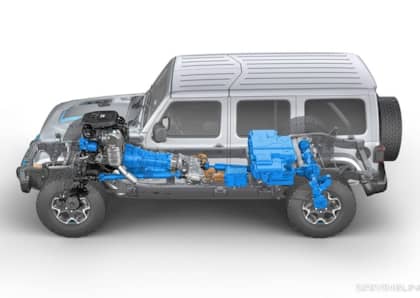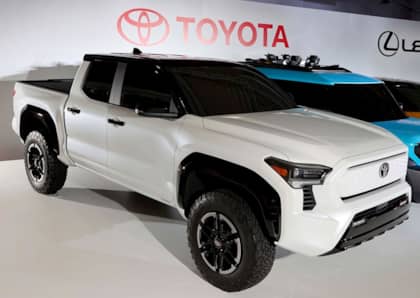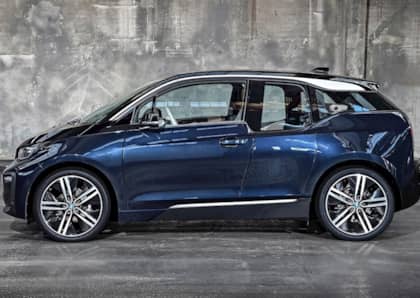Thinking About Buying an Electric Vehicle? These are the EV Terms and Definitions You Need to Know
Electric cars, plug-in hybrids, and traditional hybrids are dominating new vehicle showrooms these days, with nearly every automaker prioritizing electrified versions of its line-up over gas-only offerings.

Shopping for a new EV can make you feel like you need to learn a whole new language, which is why we put together this list of electric vehicle terms and definitions that can help you better understand the world of electrified automobiles.
Hybrid
A hybrid vehicle makes use of an electric motor and an internal combustion engine working together in a single drivetrain. Some hybrids link the electric motor directly to the wheels and can drive on battery power alone for a limited amount of time, while others operate the electric motor exclusively in tandem with the gas-powered engine.

PHEV
PHEV stands for 'plug-in hybrid electric vehicle.' This type of drivetrain combines one or more electric motors with a gas-powered internal combustion engine, but adds the extra wrinkle of a battery pack that can be recharged using an external power source.

PHEVs are both a balanced and compromised approach to EV ownership. Battery size is typically large enough to cover a day's worth of driving for the average motorist on the electric motor(s) alone, with the gas engine kicking in for longer trips. The weight of the bigger battery, however, often drops fuel mileage with the engine running below that of a similar, non-plug-in hybrid.
EV
EV stands for 'electric vehicle.' In general terms, this can be applied to any automobile that involves electricity in its drivetrain: a hybrid, a plug-in hybrid, or a pure electric vehicle. In common use, it's become shorthand for any car or truck that relies exclusively on electricity for motivation.

Driving Range
Driving range is the distance an EV can travel on a single battery charge. Range is usually a function of four things: the weight of the vehicle, the size of the battery, the energy needs of the electric motor, and the ambient temperature (with extreme heat or cold reducing driving range).

kW / kWh
Kilowatts, or kW, are a measure of electrical consumption. It's used to describe the output of an electric motor (in place of horsepower), and also the output of an electric vehicle charging station. One kilowatt is one thousand watts.

A kilowatt-hour (kWh) describes the amount of energy a battery pack can provide over the course of an hour of use. It can be thought of as a description of a battery's energy potential, or its capacity, roughly equivalent to the 'size' of a fuel tank in a gas-powered car or truck. Kilowatt-hours are also used to measure the amount of electricity transferred to a battery during a charging session.
Charging Station
A charging station provides electric current to use for charging an EV's battery pack. There are two types of charging stations available via public infrastructure: Level 2 and DC fast charging.

Charge Rate
Charge rate is the speed at which a vehicle's battery can accept electricity when plugged in. Each EV is designed with a theoretical maximum charging speed, measured in kilowatts (kW). The fastest EV charging speeds currently on the market range up to 350-kW, while at the low end you will find vehicles with 55-kW capability.

It's rare for an electric vehicle to hit its design spec charging rates in the real world. Many factors can affect charging speeds, including the number of vehicles accessing the charging station, ambient and battery temperature, and the battery's state of charge (as charging speeds slow down once a power pack has reached 80 percent capacity to help protect its power cells from damage).

Sometimes, charge rate is expressed in 'miles added per hour' of plug time, but since this can vary significantly based on the above criteria, kW is a more universal metric.
Level 1 Charging
Level 1 charging refers to plugging an EV into a standard household power outlet. Rated at 120-volts, it's the slowest method for charging a vehicle's battery, often requiring several days to top up a full EV power pack at a rate of 1.3 kW to 2.4 kW.

Level 2 Charging
Level 2 charging relies on a 240-volt power supply. It's the easiest form of charging to find at a public charging station, and it can provide a rate between 3 kW and 19 kW. It's also the most common type of home charging station due to its ease of installation.

DC Fast Charging
DC fast charging stations operate at speeds of between 50 kW and 350 kW, depending on design and load balancing. They represent the fastest type of public charging infrastructure.

Plug Type
There are four main types of plugs designed to connect directly to an EV while charging. Almost all Level 2 chargers use J1772 plugs or Combined Charging System 1 / 2 (CCS Type 1 / Type 2) plus, which integrate a J1772 plug with a DC fast charging plug in a single design. These are the most common plugs at public charging station, and are both based on Society of Automotive Engineers standards.

CHAdeMO plugs can be used with a small group of Japanese EVs for DC fast charging, but vehicles using this technology are increasingly rare. Tesla Superchargers use their own proprietary plug for fast charging.
Battery Size
Battery size is expressed in kilowatt-hours, or kWh. At its core, this measurement describes how much energy a power pack can provide across a specific period of time. The larger the number, the greater the energy potential of the battery pack.

Range Extender
A range extender is an internal combustion engine that is used not to primarily power a vehicle's wheels, but rather to serve as an electrical generator for its EV drivetrain. The BMW i3, for example, can be purchased with a range-extending engine that kicks in when the battery pack is exhausted.

The original Chevrolet Volt is often referred to as a range-extended hybrid due to the similar function of its gas-powered engine, despite being designed as an electric vehicle.
More From Driving Line
- 3 Ways To Electrify Your Classic Car (And Still Pop The Hood For Bragging Rights)
- The BMW iX Is The German Brand's First Dedicated High Performance EV SUV. How Does It Fare In A Crowded Electric Market?
- Test Drive Review: Is the 2022 Chevrolet Bolt EUV Still Relevant As An Affordable EV?
- Review: The 2022 Audi RS e-tron GT Is The Almost-Perfect Performance EV
- Comparing The 2022 Ford Mustang Mach-E To The 2022 Hyundai Ioniq 5 EV SUV
- Test Drive Review: 5 Things We Liked About The 2022 Mercedes-Benz EQS EV Flagship Sedan (And Two Things We Didn't)











